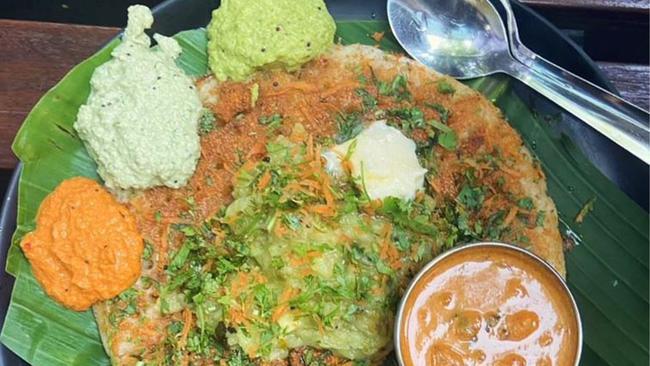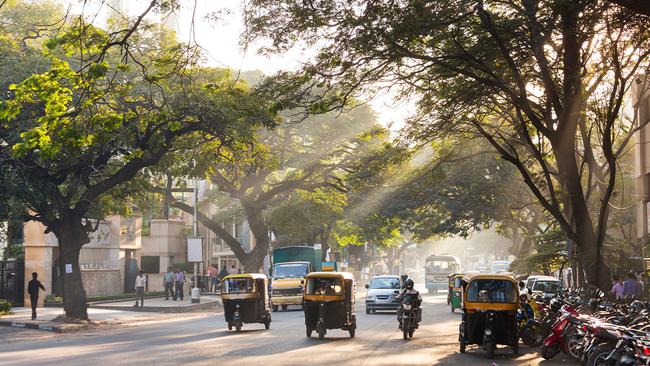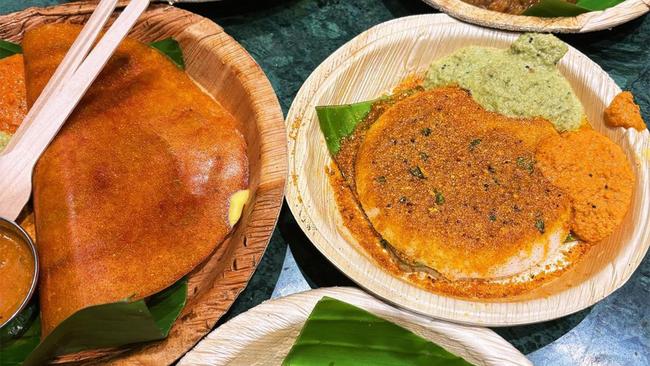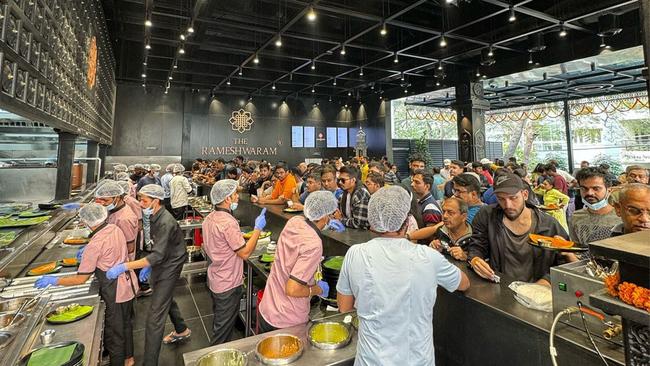Matt Preston says Bangalore is home to the best dosa in India
If there's one phrase worth knowing when you visit India, it's how to order this delicious dish.

Lifestyle
Don't miss out on the headlines from Lifestyle. Followed categories will be added to My News.
I’ve visited India seven or eight times for work and pleasure, but while I’ve picked up a smattering of French and Italian in my travels, the languages of the Indian subcontinent escape me, apart from one phrase. It’s how to order a dosa in Telugu, the language largely used in the south around Bengaluru, aka Bangalore, the city where these crisp pancakes are a near religion.
It’s a line I had to learn phonetically for the one time I filmed on a Bollywood set. The scene was simple – I walked into a magnificently rendered soundstage version of a vintage dosa shop and, to the shock of staff and customers alike, ordered a dosa flawlessly in the local tongue. The shock was such that the waiter was expected, in each of the many takes it took me to get it right, to drop the tray of metal water cups he was carrying. Again, and again, and again.

I’d been to Bangalore once, but it had been a flying visit to see an old girlfriend who I used to go clubbing with in the beer, stiletto and bare-legged-winter town of Leeds in England’s north. I had an eye-opening trip pre-MasterChef when we ate some wonderful chicken cooked with a local vinegar made from a fermented cousin of the mangosteen and went to lentil masterclasses, a concept I couldn’t fathom before the fascinating three-hour session.
While it’s the country’s fourth-biggest city, Bengaluru is not one of the cultural jewels of India. But it’s a pumping economic centre with a booming craft-beer scene, some of the country’s best nightlife and arguably the best dosa.

Now, Indian food is a conundrum – by turns complex and intricate, but also often so blindly simple you have to sit down and take stock of what kind of wonderful you have just popped into your mouth. So it is with dosa.
There are several reasons why one dosa can eclipse another and it starts with the batter. How thick it is poured for these South Indian pancakes and how hot the griddle is so the base cooks to golden perfection by the time the dosa is ready. And the batter itself is an art form – it needs just the right amount of fermentation time to ensure the dosa is light, almost fluffy, and with just a little sourness. Of course, that fermentation time changes depending on the weather and there’s a whole chemistry behind how coarse you grind your pulses or rice, and what combination you use. So dosa – simple on the surface, but a true complex art.
My favourite dosas are what are called ghee-roasted – cooked with enough ghee (butter clarified at low heat) squirted on them to ensure the face is buttery and the base is golden and deliciously crisp from frying on a hotplate and has become almost glassy.

I had one of these great dosa at a simple street café called The Rameshwaram Cafe on a leafy street in Bengaluru. You order at a counter with large hotplates behind and eat in the street or at the scattering of high benches around the shop front with the crowd clamouring to order around you. It’s always busy.
Strangely in a country with so much culinary history, this place is comparatively new, one of the first two in this emerging chain that started back in 2021. It feels, however, as though it’s been here a lot longer with its cheap back-lit menu of well-executed South Indian favourites like vadas and idlis. There’s also a range of less usual dosa made with ragi (finger millet) flour, palim (rice and black urad dal) dosa or even multigrain ones. Sure, you might go them for a change, but everyone always orders the masala podi dosa or the ghee podi dosa as well. Selling at about $3.25, this is no wispy paper dosa – it has a little fluffy height hidden under a generous sprinkle of podi (spice blend) over the buttery richness. There’s a small pot of sambar (broth) on the side and a fresh coconut chutney. Sure, the glorious buttery crispness is a core attraction, but it’s this “gunpowder” that is the real eye-opener for me.

Podi, or pudi, depending on where you are in Southern India, is a spice powder used similarly to a Middle Eastern dukkah or a Japanese furikake. It can be sprinkled generously on everything from rice to snacks and even buttered toast.
Podi originated with the Vijayanagara dynasty which, at its peak in the 15th century, ruled much of Southern India. The earliest podi, recorded in ancient Tamil scripts, were built on a grind of sesame seeds (like dukkah). These days the ingredients can be built with everything from roast chickpeas, black gram, fenugreek seeds, curry leaves, cumin or garlic to coconut, peanuts and that oniony asafoetida that is so loved in India. The grind can be fine or coarse.
Here at The Rameshwaram Cafe the podi blushes with, I suspect, ground dried red chillies, toasted raw red lentils and sesame seeds among the key elements, lifting the dosa to new heights of deliciousness. It’s so addictive that I remember thinking I’m quite glad it lives 8,987km away from my home.
But I’m even happier that it’s the one place in India where I can belly up to the counter of a street stall and order my lunch in a perfect rendition of the local lingo.
More Coverage
Originally published as Matt Preston says Bangalore is home to the best dosa in India





